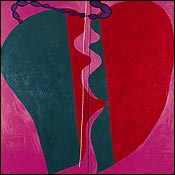
Elizabeth Murray’s retrospective at MoMA is a show of beginnings and endings: the last show here to be organized by former curator Robert Storr, and the first splashy single-artist painting survey since the museum’s renovation. In October, Murray’s bold, boisterous, and often oddly shaped canvases, inspired by Cubism, Surrealism, and Disney alike, will commandeer the vast sixth-floor galleries across from Ellsworth Kelly’s gridded wall relief and James Rosenquist’s mammoth mural F-111. “I miss the intimacy of the old building,” admits Murray, “but I think they’ll resolve that over time.” While this is the 65-year-old’s biggest and most important show to date, it’s not really her MoMA debut; she played curator in a 1995 installment of the museum’s “Artist’s Choice” series, plucking lesser-known women artists from the musty depths of its enormous permanent collection. “When I started to go through the files, it was heartbreaking,” she recalls. “They would have tons of material on the men, and just one little letter about a woman’s career.” Among her selections was the sculptor Lee Bontecou, who recently made a spectacular comeback at MoMA QNS. “People like that,” says Murray of Bontecou’s well-chronicled disappearance. “They want you to suffer and go away—it made a good story. But it is what she did, and I think it paid off for her. For some people, the pressure of being in this art world, which is so crazy and discouraging, can make you just want to get out.” After a long and remarkably consistent career that endured the austere leanings of the seventies and the bloated painterly fads of the eighties, Murray is the first female painter to land a full-scale MoMA retrospective since Helen Frankenthaler in 1989—a retrospective, moreover, that comes weighted with curatorial comparisons to Cézanne and Picasso. Not bad for an artist who once said, “I don’t see myself as part of art history … all that stuff belongs to the guys.” Does she still think that’s true? Murray pauses. “I wouldn’t say that again,” she comments. “I feel like I, and a lot of women my age and much younger, are really on the playing field—and people want us to be there.”
Elizabeth Murray
MoMA, October 23 through January 9.